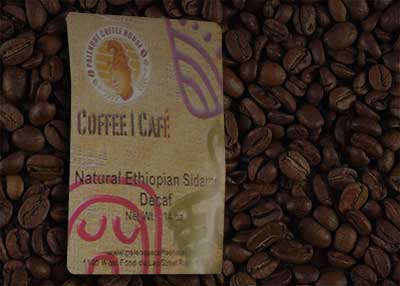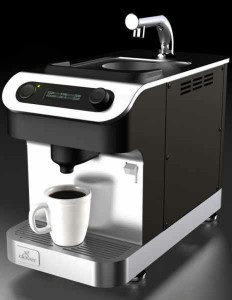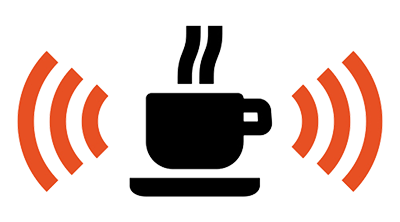Modern Roasts and Brews: A Quick Guide

In addition to variations in single origin coffee types because of geography and other factors (which we’ll continue to explore throughout this guide), modern coffee is now largely separated based on the type of roasting and brewing.
Roasting Types
Because green coffee in its natural state does not taste much like what we would consider “coffee” at all, the degree to which coffee beans are roasted has a dramatic impact on the type of flavor profiles produced. Here is a brief summary of the types of roasts available:
- Green Coffee: Coffee, essentially, at room temperature – the beans are still green, the flavor is bitter, but the coffee can be stored up to two years like this.
- Arabian or Drying Roast: The mildest of the roasts at 329 degrees Fahrenheit, the beans turn green-gold as the water evaporates. Keep in mind that Arabian coffee is roasted usually between this stage and the American Roast, so this single stage is not a comprehensive “Arabian” stage by any means.
- Cinnamon Roast: At 383 degrees Fahrenheit, the coffee finally turns a light shade of brown – or “Cinnamon” – and the expected flavors begin to develop lightly.
- New England Roast: 401 degrees Fahrenheit. This is the roast that stops roasting after the beans first crack, right before the American Roast stage.
- American Roast: This is far more common in the United States, but not much further along the line than the New England Roast.
- City Roast: Now we have entered the territory of truly popular roasts; most of the U.S. utilizes this kind of roast, at which point the single origin of the beans is much more apparent than earlier in the roasting process. About 428 degrees Fahrenheit.
- Full City Roast: Now the second crack is beginning; essentially a deeper roast version of the City Roast.
- Vienna Roast: Not far beyond the Full City Roast, the Vienna usually stops in the middle of the second cracking of the beans. The acidity of the coffee beans starts to take a backseat at this stage.
- French Roast: The beans at 464 degrees Fahrenheit are now a fully dark brown and a little “burnt” taste may start to develop. Although this is popular in Espresso, it is not as frequently used for that purpose as…
- Italian Roast: 473 degrees Fahrenheit, the beans are dark brown and nearly black and all of the acidity is nearly vanished. Most Espresso coffee blends will have been roasted to this stage.
- Spanish Roast: About as dark as it gets; generally, this is the most “burnt” flavor a coffee drinker can tolerate before the beans lose their flavor and the burnt flavor begins to dominate.
Brewing Styles
Coffee can be brewed in so many ways that it’s impossible to list them all here; instead, it may be more appropriate simply to summarize some of the most popular brewing styles utilized worldwide.
- Arabic Coffee: This is a category that generally describes two different brewing styles: Turkish-style and Saudi Coffee. Both of these styles roast the beans to milder temperatures. Arabic-style brewing could also be considered a roasting style.
- Espresso: Coming from the Italian word for “express,” Espresso coffee is brewed with pressurized boiling water that is run through coffee beans that have been ground to a fine consistency – the result is a highly-concentrated coffee that is used as the base for a number of other coffee drinks such as the Cappuccino, the Latte, and the Machiato.
- Steeping, or the French Press method: This is much more like traditional coffee brewing. The use of a French Press allows for more coarsely-ground coffee beans than the Espresso or Drip Brew methods and allows for a great deal of control. The control is achieved by how deeply the “press is pressed” – in other words, how much coffee you filter directly into the coffee/boiling water mixture. After grinding the beans, boiling water is poured in the press, whereupon you press down to separate the beans from the rest of the water. You can control how many beans you use and how deeply you press before pouring the water (now coffee) that has been separated out.
- Drip Brew, Filtered, or Traditional/American method: The generally-preferred home method in America. Hot water is run through a coffee filter full of coffee beans and the resulting drippings go into a pot. This is a little similar to the Espresso method in that it relies on dripping, but the similarities end there.
- Vacuum Pot: Utilizing vapor pressure to brew coffee, the vacuum pot enjoyed greater popularity before the middle of the 20th century – they were typically defined by what looked like two symmetrical pots, with one hanging what looks “upside-down” over the other, but is actually designed that way to suit the vacuum pressure.
- Pour Over Technique: This technique requires the use of a coffee cone, and is actually a simple method for reproducing at home: you literally pour the hot water over coffee in a filter and measure the weight as you pour. This allows you to control the strength of your cup and the end result is like a high-quality Drip Brew.
- Clover® Coffee Brewer: A favorite for those who love single origin coffee, and perhaps the best method for brewing it, especially if you have a premium single origin bean like Jamaican Blue Mountain or something similar. The occasional Starbucks™ has one of these machines, and they are available at about 150 locations outside of Starbucks™ at places like Palenque Coffee House. They utilize a Vacuum-Press™ system that allows for the digital programming of time brewed and temperature, making it perhaps the premium modern method of brewing coffee.
- Cold Drip Filter: Similar to the Drip Brew method, this is working on the same principle but is used for iced coffee drinks.
- Percolator: Perhaps the least ideal way to brew coffee, this method allows you to cycle in old and already-oxidized coffee into new coffee; a frequent method of diners of the 1950’s, and a tradition we shouldn’t remember with nostalgia.





